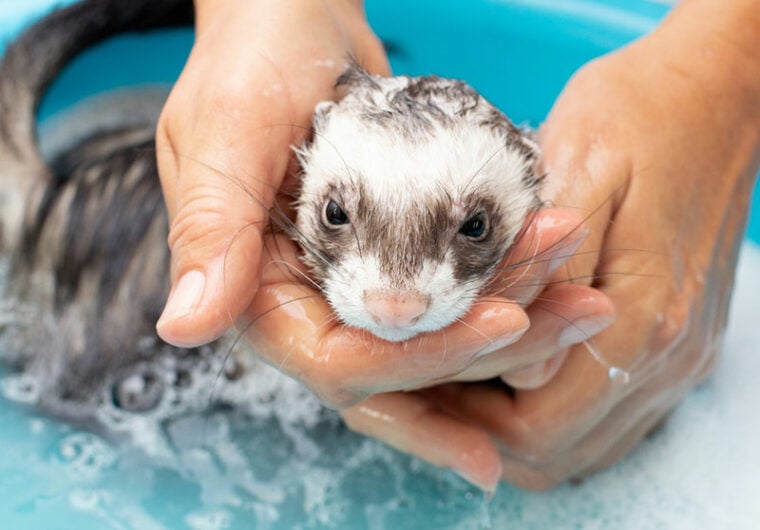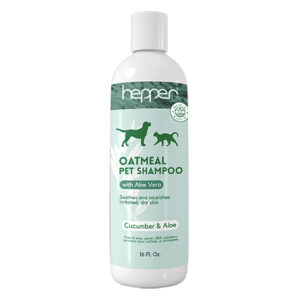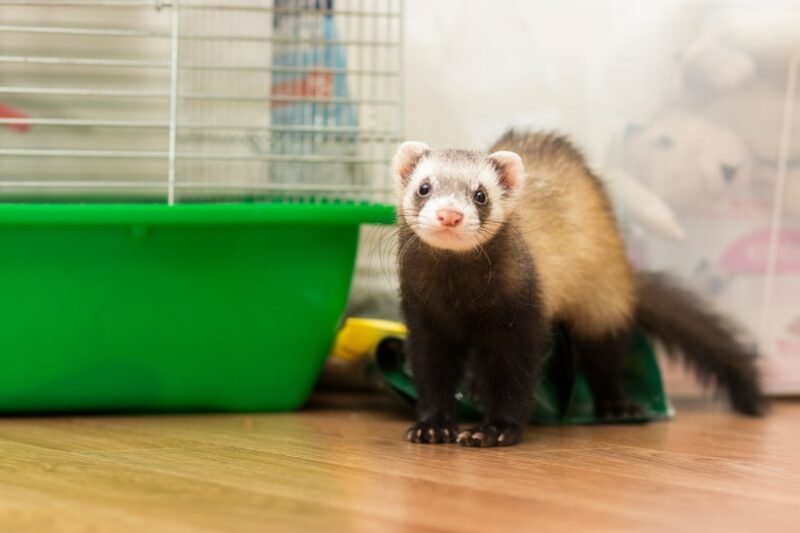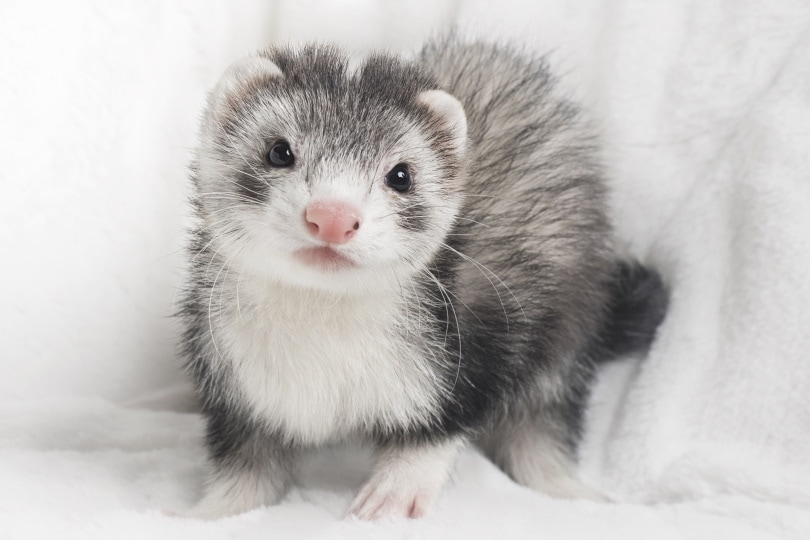
Ferrets are popular pets that can be fun to keep in your home. However, they tend to have a musky odor, and some owners may want to give them the occasional bath. If you would like to bathe your pet but aren’t sure how to do so safely, keep reading while we go over a step-by-step guide to getting your pet clean and keeping it that way. We’ll also discuss how often you should bathe your ferret and when is the best time.
The 7 Tips for Bathing Your Ferret
1. Get Your Supplies Together
You’ll need to decide whether you want to use shampoo or oatmeal for your ferret. There are several brands of shampoo that you can use that are safe to use on ferrets. These brands shouldn’t dry out the skin and will leave the fur soft with a pleasant scent. Several kinds will also remove fleas without irritating the eyes or skin. Some brands even have moisturizers that can protect the skin.
If you don’t wasn’t to use shampoo, you can create a homemade shampoo by using oatmeal soaked in water. Wrap the oats in a towel and let them sit until they become soft.
2. Run the Water
Once you have your supplies together, it’s time to get the bath water ready. You can use a tub or sink, whichever is easier for you. We like to use the kitchen sink because we can stand and it’s larger than the bathroom sink. Ferrets have a high body temperature of 101–103 °Fahrenheit (38.3-39.4°C), so you would want a bath of the same temperature. Fill the tub only a few inches until you see if your ferret likes being in the water. Ensure you support your ferret’s entire body before lowering them into the water. The water should be shallow enough so that your ferret is only submerged in the water up to their chest while their feet are touching the bottom of the tub. Their head should never be below water, and they shouldn’t have to swim to keep themselves afloat.

3. Put Your Pet in the Water
Slowly place your ferret into the water. Some ferrets will get in and swim around, while others will fight against you and try to get out. Talking in a soothing tone can help calm an excited ferret, and you can use the rinse cup to get them wet.
4. Shampoo
Once the body is wet, you can use a small amount of shampoo and rub it into the fur to create a thick lather. Make sure you don’t get any into your pet’s eyes and don’t forget the tail or belly. If you’re using oatmeal, it may be a bit harder to tell what areas you’ve covered, but the process is basically the same. Let the water get murky with the oatmeal and rub it into the fur to get it clean.
Giving your pet a bath can be a difficult task, but the first step is to choose a great shampoo. We love Hepper's Shampoo Products, both of which are natural, pet-safe options specially formulated to clean your pet's skin and coat without causing irritation. Both formulas are also free of things like dyes, soaps, sulfates, and phthalates. Your pet will enjoy the soothing aloe vera and oatmeal, and you'll love the clean, fresh scents!
 |
 |
|
|---|---|---|
| Hepper Colloidal Oatmeal Pet Shampoo | Hepper Waterless No Rinse Pet Shampoo | |
| Natural Ingredients |
Natural Ingredients:
|
Natural Ingredients:
|
| Made in USA |
Made in USA:
|
Made in USA:
|
| Safe for cats & dogs |
Safe for cats & dogs:
|
Safe for cats & dogs:
|
| Soothes dry skin |
Soothes dry skin:
|
Soothes dry skin:
|
| Waterless, no rinsing required |
Waterless, no rinsing required:
|
Waterless, no rinsing required:
|
At Pet Keen, we've admired Hepper for many years, and decided to take a controlling ownership interest so that we could benefit from the outstanding designs of this cool cat company!
5. Rinse
Once you cover the body with shampoo or oatmeal, it’s time to rinse it off. You can use the rinse cup, your hand, or a washcloth to rinse away the lather. Ensure you rinse it well because any remaining foam might dry out the skin, leading to scratching and dandruff, but don’t put any water on the head.
6. Dry Your Ferret
Ferrets like to dry themselves and can be quite entertaining when they do. Make sure you put plenty of towels on the ground because they will flop around as they dry themselves off. You can try to get some of the water off with a towel as you remove them from the water, but they usually are in a hurry to do it independently, so you will need to put it down pretty quickly.

7. All Finished
Once your ferret finishes frantically rolling around on the floor, it’s probably as dry as it’s going to get. You have completed your task, but we recommend turning up the heat a few degrees until your pet feels dry. This will prevent your ferret from getting cold. Once dry, your ferret should seem happy with its clean, soft fur, and you shouldn’t need to do it again for several months.
Do Ferrets Stink?
Ferrets are a lot like cats in the sense that they spend much of their day grooming themselves, so they usually don’t develop a strong odor. However, they tend to have a musky smell that is completely natural and part of living with a ferret. A buildup of urine in their habitat will increase the odor, as can some illnesses.
Many times, offensive odors related to ferrets are associated with their cage and litter box, and not necessarily your ferret. Thoroughly cleaning their cage, beds, and litter boxes will often help control their odor really well.
Bathing your ferret frequently to reduce their odor isn’t recommended, as it may have the opposite effect. Bathing will remove their natural oils from the skin, and at times, their bodies will go into “overdrive” to replace these oils, and will produce excess oils as a result. This may culminate in a pet that smells more than they normally would. If you have a ferret that smells worse than it should, we recommend taking it to the vet to have it looked over.

How Often Should I Bathe My Ferret?
It would be best if you only bathed your ferret occasionally. Most experts recommend doing so no more than once per month. Ideally, no more than 3–4 times a year. Frequent bathing can break down the oils in your pet’s skin, causing it to be itchy and flakey. We recommend only bathing them if they get into something that you need to wash off or if they came into contact with fleas and needed a flea bath.
Summary
We hope you have enjoyed reading over this short guide and learned some new things about your pet. We recommend only bathing your pet when necessary. Other baths are reserved for quarterly baths or if your little ferret gets into something that requires a bath immediately. If we have helped you in this article, please share these seven steps to bathe and groom a ferret on Facebook and Twitter.
Related Reads:
Featured image credit: Irina Vasilevskaia, Shutterstock










